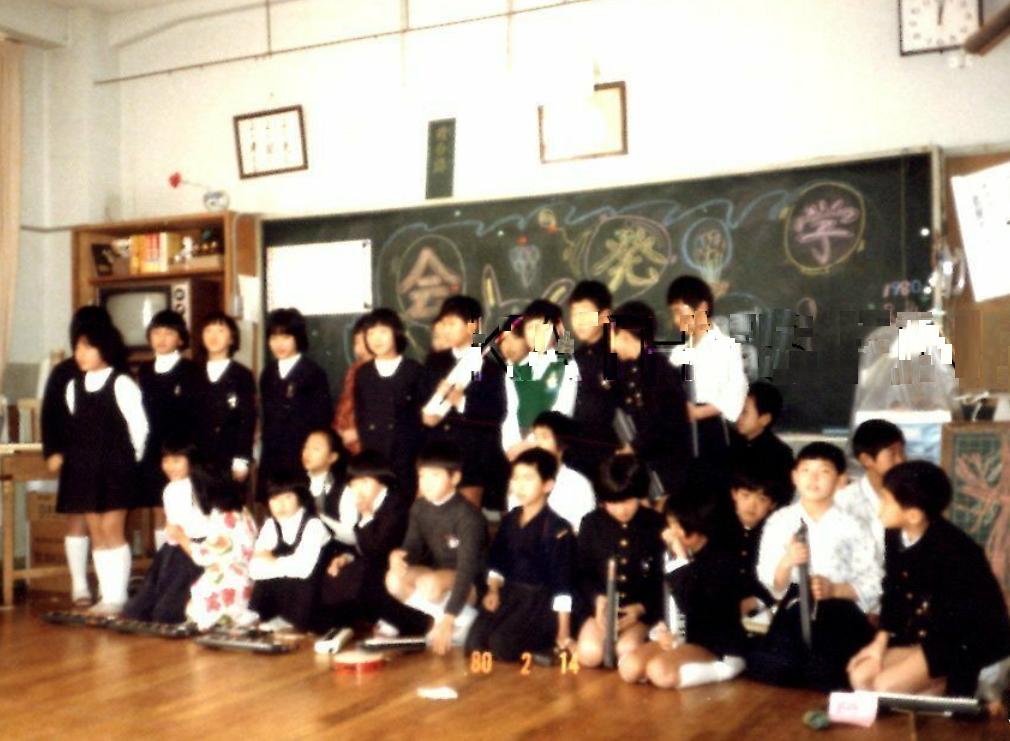
Japanese School Uniforms: Garment Rules

Figure 1.--Here we see a class at a Japanese uniform school. Unfortynately it is not real clear, but the children look to be about 10 years old. The photograph during the winter in February 1980. While the school clearly had a uniform, quite a number of the children, mostly the boys are not wearing the uniform. This is unusual as most unifor schools strctly enforced the rules. A reader writes, "I suspect it is after school as one boy seems to be wearing a karate top and another seems to be wearing a sweater of some sort." Actually I see four boys that may be wearing marshall arts white tops, but had thought those outfits were all white. These noys have white tops and dark bottoms. We see several boys holding grey rods. That may also be related to marshal arts activities. Our reader tells us that they are traditionally white; especially for novices. As you move up higher achievement gees come in black and red as well as white."
|
|
Japanese schools that adopted uniforms tended to be strict about the garments worn. Some schools were somewhat flexible about hosiery and footwear. These were the only uniform itens that schools seem willing to permit some variance among th children with uniform rules. We see boys wearing both knee socks and ankle socks at some svhhol, but not different colors, probanly becaus this stood out more. This was not the case in all uniform schools, but we do notice it at some schools. As to the other garments, most uniforms were quite strict about wearing the required items. We see countless images of Japanese scvhools with all the children cottrctly wearing the required uniform. We have noted a few schools where there was some diversity in dress, not many but we have noted a few but this was rather unusual. For the most part we notice a very high level of compliance with school uniform rules at Japanese schools. We see a far higher level of compliance with school rules in general than at american schools. An here we mean both oin the part of the chilkdren and the parents as well.
HBC-SU

Related Chronolgy Pages in the Boys' Historical Web Site
[Main Chronology Page]
[The 1900s]
[The 1910s]
[The 1920s]
[The 1930s]
[The 1940s]
[The 1950s]
[The 1960s]
[The 1970s]
[The 1980s]
[The 1990s]
[The 2000s]
Navigate the Relate Boys Historical Clothing Style Pages
[Main country page]
[Long pants suits]
[Short pants suits]
[Lederhosen]
[Kneesocks]
[Eton suits]
[Jacket and trousers]
[Blazer
[School sandals]
Navigate the Boys' Historical Clothing School Uniform Pages
[Return to the Main Japanese school uniform garment approach page]
[Return to the Main Japanese School Uniform Page]
[Return to the Main School Uniform Page]
[Australia]
[England]
[France]
[Germany]
[Ireland]
[Italy]
[Japan]
[New Zealand]
[Scotland]
[United States]
Navigate the HBC School Section:
[About Us]
[Activities]
[Chronology]
[Clothing styles]
[Countries]
[Debate]
[Economics]
[Garment]
[Gender]
[Hair]
[History]
[Home trends]
[Literary characters]
[School types]
[Significance]
[Transport and travel
[Uniform regulations]
[Year level]
[Other topics]
[Images]
[Links]
[Registration]
[Tools]
[Return to the Historic Boys' School Home]
Created: 1:48 PM 6/10/2019
Last updated: 1:48 PM 6/10/2019




